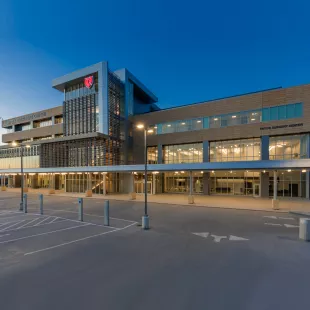Turbinate reduction can be the solution when an enlarged nasal turbinate blocks the sinus cavities.
People with a nasal obstruction have trouble breathing through their nose, especially at night when lying on their back. Many times, this difficulty breathing is caused by enlarged nasal turbinates, the bony, spongelike ridges on the inside of the nose. The ear, nose and throat (ENT) specialists at Nebraska Medicine are uniquely qualified to diagnose and successfully treat enlarged turbinates.
How Turbinate Reduction Works
Turbinates are made of bone and soft tissue. They form ridges on the inside of the nose. There are three (inferior, middle and superior), and their function is to help humidify and filter the air when you breathe. However, for some chronic sinusitis sufferers, an enlarged middle turbinate blocks the sinus cavities. Turbinate enlargement can be caused by many things, including allergies, chronic sinus inflammation, or environmental irritants. Enlarged turbinates can cause other problems, including increased snoring and chronic mouth breathing.
Turbinate Reduction is a minor procedure that can be performed in the ear, nose and throat (ENT) clinic at Nebraska Medicine under local anesthesia or in the operating room. It reduces the size of the turbinates to restore regular air flow. This should improve nasal breathing and may reduce nasal drainage and post-nasal drip.
A newer procedure is the Celon® method, which involves using selective thermotherapy to reduce the size of the nasal turbinates. The procedure can be done in the ENT clinic and takes about 10 to 15 minutes. Patients usually notice improved breathing a few days after receiving the treatment. We insert a probe into the turbinate in the nose to shrink some of the tissue within the turbinate. We use a lower-temperature technique for reduction of the turbinates. This is important because the mucous membranes are not altered, preserving normal nasal function.
A deviated septum can also contribute to nasal blockage, often caused by a past injury. When the septum is deviated, one or both sides of the nose can become blocked. In these instances, surgery can help correct the deviation and improve air flow. In some cases, a septoplasty is performed to straighten a deviated septum at the same time as turbinate reduction.
Our multidisciplinary team of ENT specialists, many of whom are fellowship trained, will conduct a thorough exam and design a plan of action that specifically addresses your needs.
Our Locations
-

Ear, Nose, Throat (ENT) and Audiology at Village Pointe Health Center
110 N 175th St.
Get Directions
Omaha, NE 68118 -

Ear, Nose, Throat (ENT), Allergy and Audiology at Lauritzen Outpatient Center
4014 Leavenworth St.
Get Directions
Omaha, NE 68105
Highly Ranked Care
Nebraska Medicine is ranked among the nation’s best. Each year, U.S. News & World Report surveys the nation’s roughly 5,000 hospitals to come up with the year’s list of Best Hospitals.
Just 3 percent of the hospitals analyzed for Best Hospitals earn national ranking in even one specialty. We were ranked nationally in ENT in the 2017 U.S. News & World Report Best Hospitals ranking and recognized as a high-performing hospital in ENT in the 2011, 2012, 2013 and 2014.